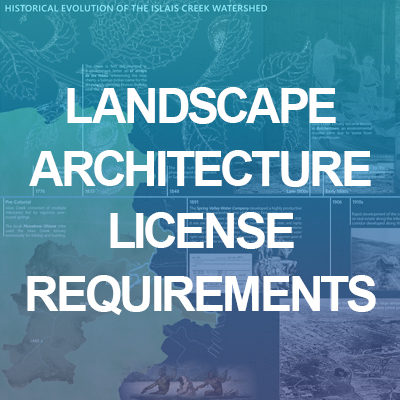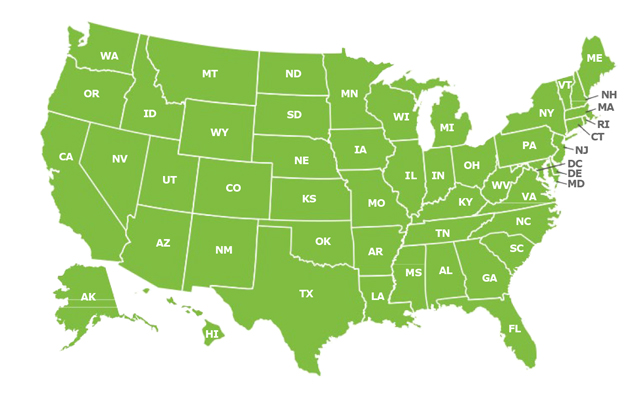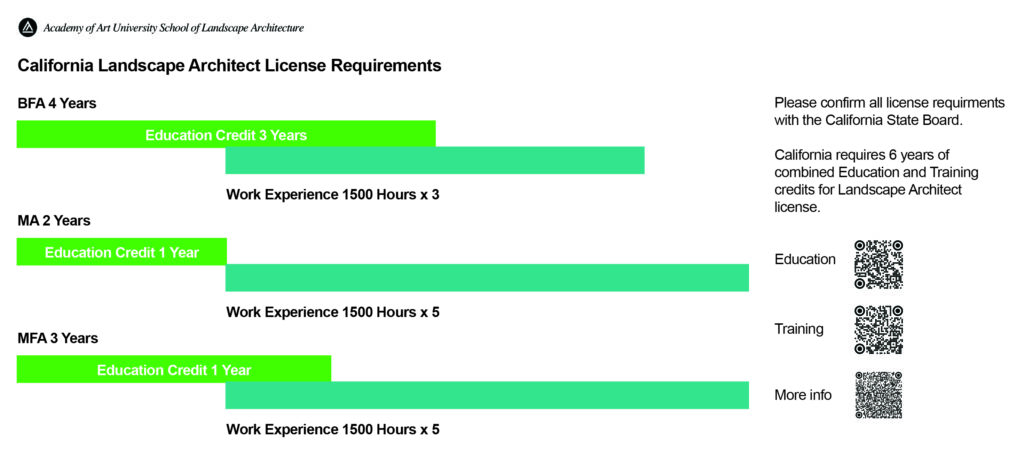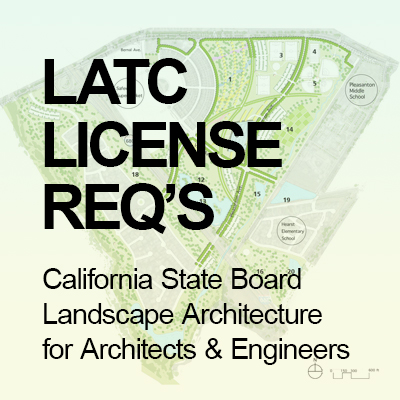
Landscape Architecture licensure requirements are determined by each state. The state boards work with non-profit organizations ASLA, CLARB, LAAB to streamline and standardize the licensure process.

ASLA stands for American Society of Landscape Architects. They have compiled the contact information for each state board on their website. Licensure requirements must be confirmed with the state board.
Download Landscape Architecture Licensure Overview from ASLA
CLARB stands for Council of Landscape Architectural Registration Boards. CLARB administers the licensing exams, called Landscape Architect Registration Examination (LARE), and coordinates exam eligibility with the state boards. They have compiled information on their website to show which states require LAAB accredited degrees for licensure. Please use the CLARB web page as a reference but the confirmation should always come from the state board.
Download LARE Orientation Guide from CLARB
Report your education and work experience to CLARB by creating a Council Record account. View a tutorial video by CLARB.
LAAB stands for Landscape Architectural Accreditation Board. Information from LAAB: Accreditation is a non-governmental, voluntary system of self-regulation. Its core is the concept of self-evaluation. The Landscape Architectural Accreditation Board (LAAB) accreditation process evaluates each program on the basis of its stated objectives and compliance to externally mandated minimum standards. The program conducts a self-study to evaluate how well it is meeting its educational goals. LAAB then provides an independent assessment, which determines if a program meets accreditation requirements. Programs leading to first professional degrees at the bachelor’s or master’s levels in the United States are eligible to apply for accreditation from LAAB. See a list of programs accredited by LAAB.
LATC stands for Landscape Architects Technical Committee and is under the purview of the California Architects Board. LATC determines licensure requirements. California offers multiple paths to licensure. Candidates with degrees not accredited by LAAB can substitute with work experience. A total of 6 years is required which can be comprised of education and experience. https://www.latc.ca.gov/candidates/becoming_a_landscape_architect/
California state board requires 6 years of “qualifying education and training experience, as specified in Section 2620 – Education and Training Credits” to be eligible to take the licensing exams.
- 4-year degree in landscape architecture not accredited by LAAB : 3 year credit
- 2-year or 3-year degree in landscape architecture: 1 year credit

In California, a candidate who has a combination of 6 years of qualifying education and training experience shall be eligible and may apply for the Landscape Architect Registration Examination (LARE). California requires a minimum of 1 year of training credit.
In California, 1 year of training credit consists of 1,500 hours of qualifying employment. Students can start accruing training credit before graduation. Employment can be part time or full time.
- Experience obtained under the direct supervision of a licensed landscape architect: Up to 6 years credit
- Experience as a licensed landscape contractor: Up to 4 years credit
- Experience obtained under the direct supervision of a licensed landscape contractor: Up to 1 year credit
- Experience as a licensed architect or registered civil engineer: Up to 3 years credit
Information from LATC: The Landscape Architect Registration Examination (LARE) is the national licensing examination that measures knowledge, skills, and abilities as they relate to the profession of landscape architecture; it is a product of the Council of Landscape Architectural Registration Boards (CLARB) and formally adopted by California as its licensure examination. It consists of four multiple-choice sections. Visit CLARB for more information on the scope, structure and preparation guide for the LARE. CLARB also has resources for exam candidates on their website that include practice tests and other resources to help candidates better understand the content, format, and delivery for each section of the LARE.
| LARE Pass Rates | 2024 Dec | 2024 Aug | 2024 Apr | 2023 Dec |
| Section 1 Inventory, Analysis and Project Management | 64% | 65% | 66% | 64% |
| Section 2 Planning and Design | 61% | 60% | 63% | 63% |
| Section 3 Construction Documentation & Administration | 76% | 74% | 60% | 60% |
| Section 4 Grading, Drainage and Stormwater Management | 53% | 53% | 59% | 49% |
https://my.clarb.org/take-the-exam/view-exam-results-pass-rates
LARE Sub-Sections
| LARE Sections | Sub-Domain 1 | Sub-Domain 3 | Sub-Domain 3 | Sub-Domain 4 | Sub-Domain 5 |
| Section 1 Inventory, Analysis and Project Management | Project Management (7%) | Inventory & Data Collection (21%) | Stakeholder Engagement Process (14%) | Physical Analysis (39%) | Contextual Analysis (19%) |
| Section 2 Planning and Design | Stewardship & Design Principles (17%) | Master Planning (33%) | Schematic Design (28%) | Design Development (22%) | |
| Section 3 Construction Documentation & Administration | Construction Plans & Details (50%) | Construction Specifications & Bidding (20%) | Construction Administration (30%) | ||
| Section 4 Grading, Drainage and Stormwater Management | Stormwater Management (39%) | Grading & Earthwork (44%) | Drainage Systems (17%) |
https://my.clarb.org/take-the-exam/view-exam-results-pass-rates
| LARE Sections | Fee |
| Section 1 Inventory, Analysis and Project Management | $535.00 |
| Section 2 Planning and Design | $535.00 |
| Section 3 Construction Documentation & Administration | $535.00 |
| Section 4 Grading, Drainage and Stormwater Management | $535.00 |
https://www.clarb.org/take-the-exam/view-exam-dates-deadlines-and-fees

